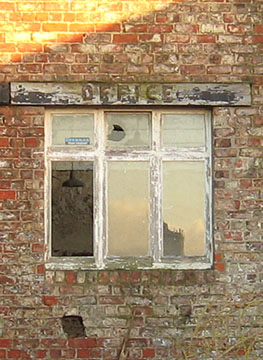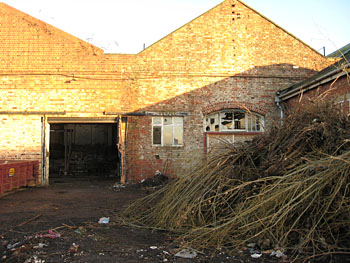Just drawing together the information found, in case it’s of interest to others, as these buildings have been of interest to me since I first wandered in to have a look in 2004. For photos of the exterior of the older workshops, taken earlier this year, see this page. There’s also an album on Picasaweb.
Map and background information
Map showing demolition site: Google map

Relevant documents on the CoYC planning pages (ref 11/02761/DMNOT) include a location plan and a report, containing historical information on the site.
Historical significance
The buildings being demolished include the remains of 19th century iron foundries, as stated on the Local List website (Iron foundries, Leeman Road) and the City of York HER record.

The 1891 town plan on www.old-maps.co.uk marks the site and its (large) workshops as ‘Phoenix & Albion Works (Iron)’ (co-ordinates 458908 and 451986 should take you to the location). The ironworks buildings wrap around to the west and to the south of the terraced streets of Carlisle St and Carleton St, where the workers lived. (Carlisle St was once built up on both sides, with one side backing on to the foundry wall. This is now a grassed area and may have been cleared after bomb damage in the war.)
Foundries lecture: January 2013
Railway historian Bill Fawcett recorded the site before demolition. He has produced an illustrated report covering the history and development of the Phoenix foundry on this site. Alongside the demolition site are buildings which formed the Albion foundry. The history of both these foundries at Leeman Road and at their earlier site is the subject of a YAYAS lecture on Wednesday 16th January 2013 at the Friends’ Meeting House, Friargate, York. More information
Bill Fawcett’s research on the foundries featured in a piece in The Press, in 2003: Teardrop treasures.
Photos
I took a few photos of the exterior of the older buildings on the site in 2004, and on a couple of visits this year before demolition. See my album on Picasaweb
Nathan Reynolds has excellent photos of these and other buildings, and has been keeping a photographic record of the recent demolition work in a set on flickr.com.
Also on flickr.com: photos by Dash Wortley, and me.
Why it matters
Comments by the Conservation Area Advisory Panel, from the report mentioned above:
‘… the buildings proposed for demolition in this application occupy the site of, and retain some of the fabric of, the Phoenix Foundry of the York Engineering Co. The long established Phoenix Foundry moved from the Fishergate area in the mid 1870s to a new Leeman Road site at about the same time as the Albion Foundry, from premises at Monk Bar. In 1882, the two businesses combined to form the York Engineering Company, to produce a wide range of cast- and wrought-iron items for the North Eastern Railway Company, including columns, girders, station roofs and railway bridges. Eventually, the premises were sold to the North Eastern Railway after which the site was developed by the Civil Engineer’s department for maintenance workshops …
… Much of York’s railway history has already been lost through demolitions elsewhere. Indeed, because of the limited extent of industrial activity in York in the nineteenth century, the surviving fabric on the York Central site represents a significant proportion of all York’s industrial heritage. Certainly it was crucial to the development of what heavy industry there was, much of which was dependent on the upkeep, maintenance and spread of the railway network. The significance of the buildings which are the subject of this application lies in the contribution made by the iron foundries to the industrial activity represented by the site.’
The other view
A body called the Railway Heritage Trust had apparently been consulted regarding the demolition notice, so I emailed to see if they had a view. The trust’s website states that it is independent of Network Rail, but that Network Rail is one of its sponsors, so I’m not sure how that works. Anyway, in the interests of balance, this is the Railway Heritage Trust’s view of the buildings:
‘They are in a very poor state, and there is no obvious further use for them. There is little of obvious historic interest in them, they are pretty standard industrial buildings of their time, but much altered over the years … no grounds for opposing their re-development. However, in agreement with the City, Network Rail has commissioned a full study of the buildings by an expert on the North Eastern Railway [Bill Fawcett, see above] … a local heritage architects firm has done a full plot of all railway buildings in York on a time line, that shows the construction time of the Leeman Road buildings in the context of the development of the railway and its other buildings.
… this is as good as can be hoped for for a building that clearly does not merit listing, and has no economic use.’
Permanent Way
The sign on the gateway still says ‘Permanent Way Engineer’. See also: Keeping it all on track (The Press)





This may be of interest being details of the Albion Company and its involvement with the gasworks industry http://www.gracesguide.co.uk/William_Knapton
Pingback: York’s railway history – there to see in current buildings – Sue Gough – me and mine